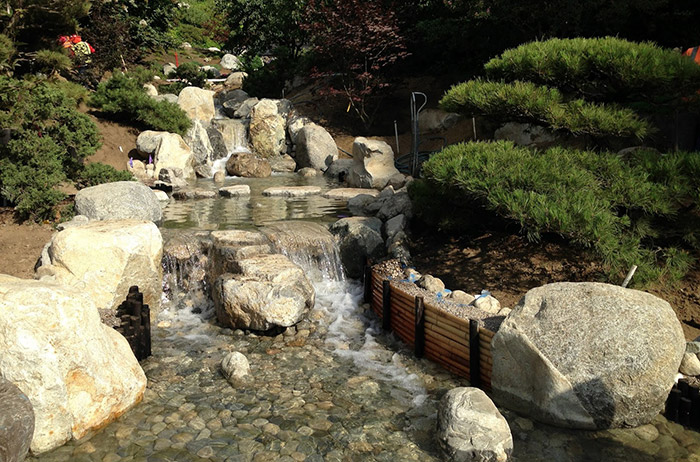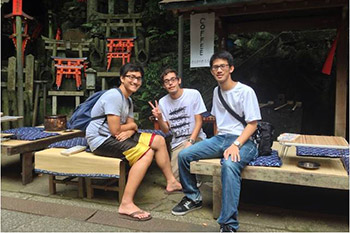UC San Diego Computer Science Student Develops App for Balboa Park
By:
- Doug Ramsey
Published Date
By:
- Doug Ramsey
Share This:
Article Content

Japanese Friendship Garden, Balboa Park, San Diego
Here’s How It Works
Visitors entering the Japanese Friendship Garden will be invited to download the Haiku Hunt App to their Android mobile phones. The app shows a map of the garden, and the visitor is presented with 10 different haikus, related Japanese sumi-e (ink brush) drawings, and sound clues. Each haiku is a riddle pointing to a specific location in the garden. If the visitor can figure out the riddle and walks to within approximately ten feet of the location, the app unlocks details about plant collections near the Place Sticker, including its place of origin and history. Figure out all ten riddles and the visitor gets a coupon reward.
Crowdsourcing, solar-powered sensors, a mobile app, and a Kickstarter fundraising campaign.
That may sound like the trappings of a hot new high-tech startup, but this is the Japanese Friendship Garden Haiku Hunt. It’s a 21st-century scavenger hunt for visitors of all ages who will be able to use their Android smart phones to enhance and enrich their experience when visiting the nearly 100-year-old gardens in San Diego’s Balboa Park.
The Android app was developed over the summer by University of California, San Diego undergraduate Jesus Rios, while doing an internship in Osaka as part of the Pacific Rim Experiences for Undergraduates (PRIME) program. Based in Calit2’s Qualcomm Institute and funded by the National Science Foundation, Balboa Park Online Collaborative (BPOC), and the National Institute for Information and Communication Technology (NICT), PRIME sent the Computer Science and Engineering (CSE) senior to work in Japan’s National Institute of Information and Communications Technology (NICT), where Rios developed the mobile app under the guidance of his host-country advisor, professor Shinji Shimojo, and UCSD Research Scientist Jason Haga.
The project was pulled together by the Balboa Park Online Collaborative (BPOC). “The Japanese Friendship Garden had a new initiative to incorporate technology into their garden and provided the content, PRIME provided the student programmer, NICT and BPOC provided technical expertise, and Information Services International-Dentsu [ISID] provided the location-based Wi-Fi chips, including new solar versions,” said Vivian Kung Haga, Director and CEO of BPOC. “It is rare to find a collaboration that is mutually beneficial and truly successful. We have it here, which is why BPOC continues to work with PRIME and its partners.”
BPOC is also turning to the crowdfunding website Kickstarter to raise the last $2,500 needed to complete the project and deploy the technology in the Japanese Friendship Garden. But there’s a catch: if the full amount is not raised by the November 24 deadline, the funds will be returned to donors. As of Veterans Day, about one-fifth of the target amount had been pledged (in amounts as low as $25).

From left, Thinh Nguyen, Jesus Rios and Kittinan Ponkaew
“The Haiku Hunt will give visitors, including children, an exciting new way to visit the garden and learn about the Japanese garden elements,” said Luanne Kanzawa, Executive Director of the Japanese Friendship Garden. “We are hopeful that our supporters in San Diego will want to meet the challenge and go to the Kickstarter page set up by the Balboa Park Online Collaborative.”
“We have wanted to use Kickstarter for awhile,” noted BPOC’s Director. “The Haiku Hunt is our first Kickstarter and we felt that it was a great fit for a crowdsourced campaign, because the app itself was built on a crowdsourced contest.”
Indeed, even as Jesus Rios was working on the app in Japan over the summer, visitors to the Japanese Friendship Garden website were being asked to create haikus (a form of Japanese poetry) as riddles pointing to the ten locations in the garden to be featured in the scavenger hunt. Artists were also invited to create abstract Japanese sumi-e (ink brush) drawings of each location. The best haikus and drawings were integrated into the app.
No one wants to see the Kickstarter campaign succeed more than Jesus Rios. Now a senior in the Computer Science and Engineering (CSE) department of UCSD’s Jacobs School of Engineering, Rios has experience with Java, C/C++ and Javascript programming, and his interests include mobile development and front-end engineering.
Since returning to UCSD in September, Rios has been working part-time to finish the last bits of coding to make the Android app ready for the real world.
Like other students in the PRIME program, which dispatched 12 UCSD undergrads to five countries in 2013, Rios was required to report weekly on his cultural exploration of the host country, as well as his progress on developing the app:
“Week 6 Progress Update: Added unlockable Information page with feedback (vibration) when a user solves a Riddle. Map of the garden added to the app. Prototype testing in lab (no issues encountered).” (To read all of his reports, visit the PRIME Student Voices section.)
“The Haiku Hunt was designed to give the user a different kind of experience in the garden,” recalled Rios. “The user can learn more about the garden’s collections, and also have fun in the process.”
At the core of the project are the Place Sticker chips developed by ISID. The chips – not yet commercial, so they are being provided for free for the Haiku Hunt project – can serve as permanently active sensors. UCSD’s Rios used the PlaceSticker Android API (after getting past the fact that it was only available in Japanese!) in programming the app to recognize when the device is sending a low-power Wi-Fi signal to a nearby visitor’s smart phone.
PlaceStickers were demonstrated as part of another BPOC project in April at Balboa Park’s Timken Museum of Art. For a wireless museum tour, each chip was affixed near a painting in the Timken collection, conveying information about the artwork whenever a visitor’s smart phone was in range.
The deployment in the Japanese Friendship Garden is more complicated. The PlaceSticker chips must be located outdoors, including in some areas where Wi-Fi coverage is not currently available. ISID modified the device to transmit a Wi-Fi signal a short distance, so it could work with Android phones even in areas without general Wi-Fi coverage. ISID also implemented a solar-powered version, since it would otherwise be difficult to keep changing regular batteries in the 10 Place Stickers deployed around the Garden.
The outdoor deployment is a major reason for the Kickstarter campaign. According to BPOC, it will have to purchase waterproof containers for the Place Stickers, Kickstarter funds would also be used to finish programming the app, and to install the Place Stickers in the garden.
“The Haiku Hunt will be the first outdoor deployment of the PlaceSticker technology,” said Jason Haga, the Research Scientist in UCSD’s Department of Bioengineering who has mentored Jesus Rios and several previous undergrads in the PRIME program. “Our continued success demonstrates the excellent quality of UCSD's undergraduates and their ability to produce high-quality and high-impact results.”
When a visitor solves one of the haiku riddles and gets to within a few feet of the secret location in the garden, the app will unlock information on the smart phone. If visitors solve all ten puzzles, they will get a coupon reward. The mobile app will also include information on new features in the Japanese Friendship Garden’s nine-acre expansion area, which will be completed in January 2015 in time for Balboa Park’s centennial celebration in 2015.
A prototype of the Haiku Hunt app was demonstrated in Japan before UCSD’s Rios ended his summer internship. It was presented at The Active Lab, an exhibition space in Osaka that gives consumers the opportunity to interact with not-yet-commercial technologies from companies, universities and other institutions.
Rios acknowledges a large group of advisors who helped guide his work on the project. They included: at the Garden, Marisa Espinosa and Luanne Kanzawa; at the Balboa Park Online Collaborative, Vivian Kung Haga, Christina DePaolo and Wesley Hsu; PRIME host country advisor Shinji Shimojo and others at Japan’s National Institute of Information and Technology (NICT); and at UC San Diego, his primary advisor, Jason Haga, and other members of the PRIME team, including co-directors Gabriele Wienhausen and Peter Arzberger.
Share This:
Stay in the Know
Keep up with all the latest from UC San Diego. Subscribe to the newsletter today.



